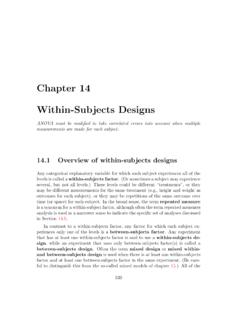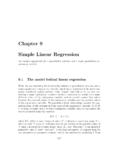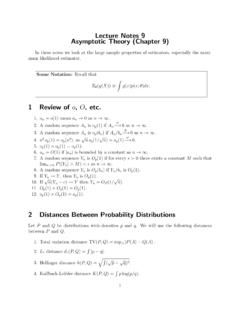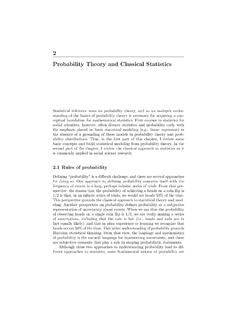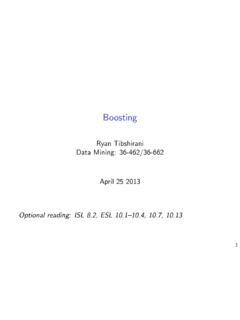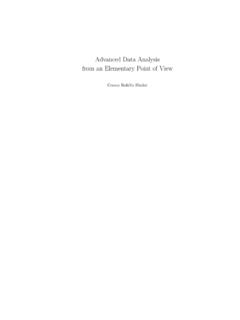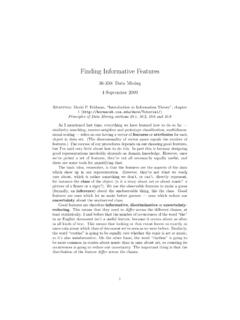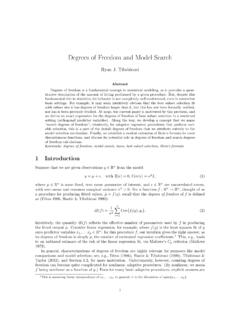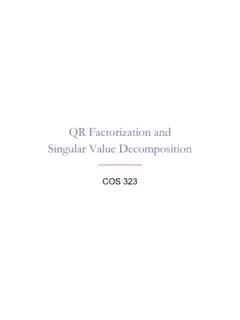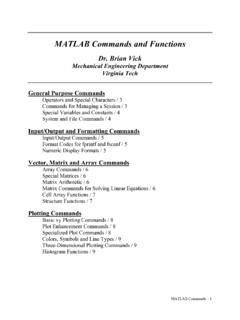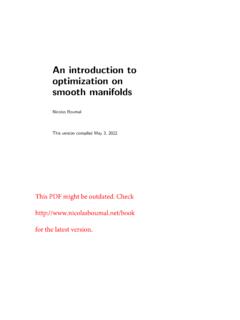Transcription of The Lasso Problem and Uniqueness - Carnegie Mellon …
1 The Lasso Problem and Uniqueness Ryan J. Tibshirani Carnegie Mellon University Abstract The Lasso is a popular tool for sparse linear regression, especially for problems in which the number of variables p exceeds the number of observations n. But when p > n, the Lasso criterion is not strictly convex, and hence it may not have a unique minimizer. An important question is: when is the Lasso solution well-defined (unique)? We review results from the literature, which show that if the predictor variables are drawn from a continuous probability distribution, then there is a unique Lasso solution with probability one, regardless of the sizes of n and p. We also show that this result extends easily to `1 penalized minimization problems over a wide range of loss functions.
2 A second important question is: how can we manage the case of non- Uniqueness in Lasso solutions? In light of the aforementioned result, this case really only arises when some of the predictor variables are discrete, or when some post-processing has been performed on continuous predictor measurements. Though we certainly cannot claim to provide a complete answer to such a broad question, we do present progress towards understanding some aspects of non- Uniqueness . First, we extend the LARS algorithm for computing the Lasso solution path to cover the non-unique case, so that this path algorithm works for any predictor matrix. Next, we derive a simple method for computing the component-wise uncertainty in Lasso solutions of any given Problem instance, based on linear programming.
3 Finally, we review results from the literature on some of the unifying properties of Lasso solutions, and also point out particular forms of solutions that have distinctive properties. 1 Introduction We consider `1 penalized linear regression, also known as the Lasso Problem (Tibshirani 1996, Chen et al. 1998). Given a outcome vector y Rn , a matrix X Rn p of predictor variables, and a tuning parameter 0, the Lasso estimate can be defined as 1. argmin ky X k22 + k k1 . (1). Rp 2. The Lasso solution is unique when rank(X) = p, because the criterion is strictly convex. But the criterion is not strictly convex when rank(X) < p, and so there can be multiple minimizers of the Lasso criterion (emphasized by the element notation in (1)).
4 Note that when the number of variables exceeds the number of observations, p > n, we must have rank(X) < p. The Lasso is quite a popular tool for estimating the coefficients in a linear model, especially in the high-dimensional setting, p > n. Depending on the value of the tuning parameter , solutions of the Lasso Problem will have many coefficients set exactly to zero, due to the nature of the `1 penalty. We tend to think of the support set of a Lasso solution , written A = supp( ) {1, .. p} and often referred to as the active set, as describing a particular subset of important variables for the linear model of y on X. Recently, there has been a lot of interesting work legitimizing this claim by proving desirable properties of or its active set A, in terms of estimation error or model recovery.
5 1. Most of this work falls into the setting p > n. But such properties are not the focus of the current paper. Instead, our focus somewhat simpler, and at somewhat more of a basic level: we investigate issues concerning the Uniqueness or non- Uniqueness of Lasso solutions. Let us first take a step back, and consider the usual linear regression estimate (given by = 0. in (1)), as a motivating example. Students of statistics are taught to distrust the coefficients given by linear regression when p > n. We may ask: why? Arguably, the main reason is that the linear regression solution is not unique when p > n (or more precisely, when rank(X) < p), and further, this non- Uniqueness occurs in such a way that we can always find a variable i {1.}
6 P} whose coefficient is positive at one solution and negative at another. (Adding any element of the null space of X to one least squares solution produces another solution.) This makes it generally impossible to interpret the linear regression estimate when p > n. Meanwhile, the Lasso estimate is also not unique when p > n (or when rank(X) < p), but it is commonly used in this case, and in practice little attention is paid to Uniqueness . Upon reflection, this seems somewhat surprising, because non- Uniqueness of solutions can cause major problems in terms of interpretation (as demonstrated by the linear regression case). Two basic questions are: Do Lasso estimates suffer from the same sign inconsistencies as do linear regression estimates?
7 That is, for a fixed , can one Lasso solution have a positive ith coefficient, and another have a negative ith coefficient? Must any two Lasso solutions, at the same value of , necessarily share the same support, and differ only in their estimates of the nonzero coefficient values? Or can different Lasso solutions exhibit different active sets? Consider the following example, concerning the second question. Here we let n = 5 and p = 10. For a particular outcome y R5 and predictor matrix X R5 10 , and = 1, we found two solutions of the Lasso Problem (1), using two different algorithms. These are (1) = ( , , , , .. , 0)T and (2) = ( , , , 0, .. , 0)T , where we use ellipses to denote all zeros.
8 In other words, the first solution has support set {1, 2, 3, 4}, and the second has support set {1, 2, 3}. This is not at all ideal for the purposes of interpretation, because depending on which algorithm we used to minimize the Lasso criterion, we may have consid- ered the 4th variable to be important or not. Moreover, who knows which variables may have zero coefficients at other solutions? In Section 2, we show that if the entries of the predictor matrix X are drawn from a continuous probability distribution, then we essentially never have to worry about the latter Problem along with the Problem of sign inconsistencies, and any other issues relating to non- Uniqueness because the Lasso solution is unique with probability one.
9 We emphasize that here Uniqueness is ensured with probability one (over the distribution of X) regardless of the sizes of n and p. This result has basically appeared in various forms in the literature, but is perhaps not as well-known as it should be. Section 2 gives a detailed review of why this fact is true. Therefore, the two questions raised above only need to be addressed in the case that X contains discrete predictors, or contains some kind of post-processed versions of continuously drawn predictor measurements. To put it bluntly (and save any dramatic tension), the answer to the first question is no . In other words, no two Lasso solutions can attach opposite signed coefficients to the same variable.
10 We show this using a very simple argument in Section 4. As for the second question, the example above already shows that the answer is unfortunately yes . However, the multiplicity of active sets can be dealt with in a principled manner, as we argue in Section 4. Here we show how to compute lower and upper bounds on the coefficients of Lasso solutions of any particular Problem instance this reveals exactly which variables are assigned zero coefficients at some Lasso solutions, and which variables have nonzero coefficients at all Lasso solutions. 2. Apart from addressing these two questions, we also attempt to better understand the non-unique case through other means.
